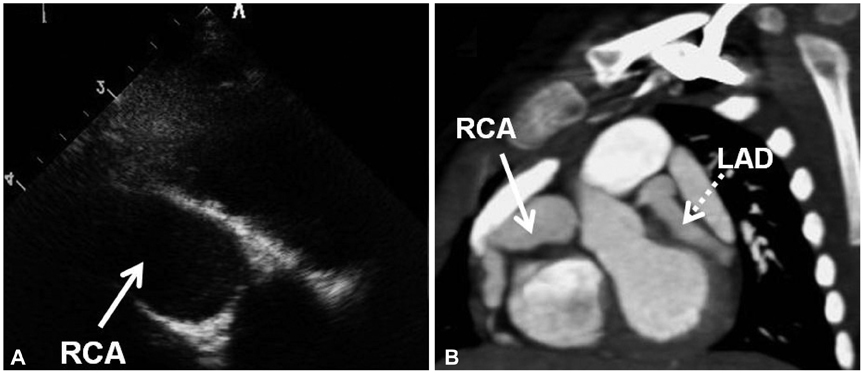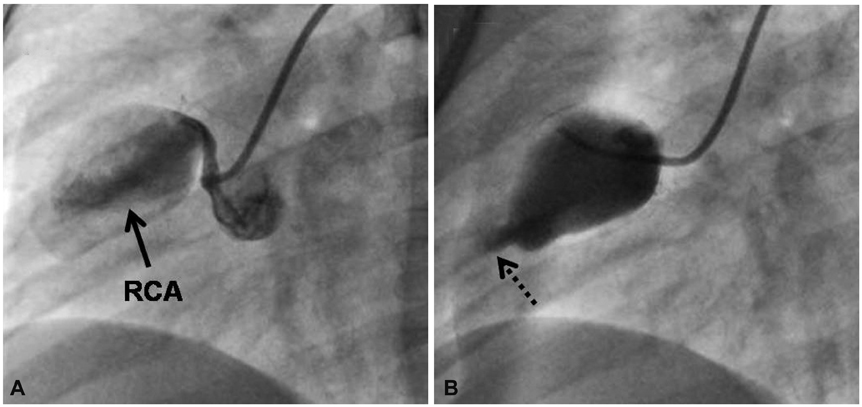Korean Circ J.
2014 Jan;44(1):54-58. 10.4070/kcj.2014.44.1.54.
Two Cases of Super-Giant Coronary Aneurysms after Kawasaki Disease
- Affiliations
-
- 1Department of Pediatrics, Seoul National University Children's Hospital, Seoul, Korea. ped9526@snu.ac.kr
- KMID: 1859244
- DOI: http://doi.org/10.4070/kcj.2014.44.1.54
Abstract
- Acute giant coronary aneurysm after Kawasaki disease (KD) is a catastrophic complication that can be fatal and very difficult to manage. However, no fixed consensus has been reached for the management of super-giant coronary aneurysms in the acute setting. Here, we report the successful management of young children with super-giant coronary aneurysms after KD. Based on our experience, hemodynamic stabilization to prevent further coronary dilation or rupture and strict anticoagulation to avoid thrombus formation are mandatory in the management of this condition.
MeSH Terms
Figure
Cited by 1 articles
-
Infliximab Treatment for Intravenous Immunoglobulin-resistant Kawasaki Disease: a Multicenter Study in Korea
Gyu Hur, Min Seob Song, Sejung Sohn, Hyoung Doo Lee, Gi Beom Kim, Hwa Jin Cho, Kyung Lim Yoon, Chan Uhng Joo, Myung Chul Hyun, Chul Ho Kim
Korean Circ J. 2019;49(2):183-191. doi: 10.4070/kcj.2018.0214.
Reference
-
1. Burns JC, Kushner HI, Bastian JF, et al. Kawasaki disease: a brief history. Pediatrics. 2000; 106:E27.2. Burns JC, Glodé MP. Kawasaki syndrome. Lancet. 2004; 364:533–544.3. Kato H, Sugimura T, Akagi T, et al. Long-term consequences of Kawasaki disease. A 10- to 21-year follow-up study of 594 patients. Circulation. 1996; 94:1379–1385.4. Suda K, Kudo Y, Higaki T, et al. Multicenter and retrospective case study of warfarin and aspirin combination therapy in patients with giant coronary aneurysms caused by Kawasaki disease. Circ J. 2009; 73:1319–1323.5. Uehara R, Belay ED. Epidemiology of Kawasaki disease in Asia, Europe, and the United States. J Epidemiol. 2012; 22:79–85.6. McNeal-Davidson A, Fournier A, Scuccimarri R, et al. The fate and observed management of giant coronary artery aneurysms secondary to Kawasaki disease in the Province of Quebec: the complete series since 1976. Pediatr Cardiol. 2013; 34:170–178.7. Suzuki N, Seguchi M, Kouno C, Inukai K, Kito H, Kobayashi H. Rupture of coronary aneurysm in Kawasaki disease. Pediatr Int. 1999; 41:318–320.8. Imai Y, Sunagawa K, Ayusawa M, et al. A fatal case of ruptured giant coronary artery aneurysm. Eur J Pediatr. 2006; 165:130–133.9. Panzer J, De Jaeger A, Suys B. Rupture of giant coronary arterial aneurysm without progressive dilation. Cardiol Young. 2008; 18:189–190.10. Sunagawa K, Mitsumata M, Ayusawa M, Kusumi Y. Ruptured giant aneurysm of the left anterior descending coronary artery in Kawasaki disease. Pediatr Cardiol. 2008; 29:1115–1119.11. Kuramochi Y, Ohkubo T, Takechi N, Fukumi D, Uchikoba Y, Ogawa S. Hemodynamic factors of thrombus formation in coronary aneurysms associated with Kawasaki disease. Pediatr Int. 2000; 42:470–475.12. Ohkubo T, Fukazawa R, Ikegami E, Ogawa S. Reduced shear stress and disturbed flow may lead to coronary aneurysm and thrombus formations. Pediatr Int. 2007; 49:1–7.13. Kato H, Inoue O, Ichinose E, Akagi T, Sato N. Intracoronary urokinase in Kawasaki disease: treatment and prevention of myocardial infarction. Acta Paediatr Jpn. 1991; 33:27–35.14. Kato H, Koike S, Yokoyama T. Kawasaki disease: effect of treatment on coronary artery involvement. Pediatrics. 1979; 63:175–179.15. Kobayashi T, Saji T, Otani T, et al. Efficacy of immunoglobulin plus prednisolone for prevention of coronary artery abnormalities in severe Kawasaki disease (RAISE study): a randomised, open-label, blinded-endpoints trial. Lancet. 2012; 379:1613–1620.16. Chen S, Dong Y, Yin Y, Krucoff MW. Intravenous immunoglobulin plus corticosteroid to prevent coronary artery abnormalities in Kawasaki disease: a meta-analysis. Heart. 2013; 99:76–82.17. Hashino K, Ishii M, Iemura M, Akagi T, Kato H. Re-treatment for immune globulin-resistant Kawasaki disease: a comparative study of additional immune globulin and steroid pulse therapy. Pediatr Int. 2001; 43:211–217.
- Full Text Links
- Actions
-
Cited
- CITED
-
- Close
- Share
- Similar articles
-
- A Case of Right Coronary Arterial Occlusion with Normal Electrocardiogram in Atypical Kawasaki Diseases
- Unusual Presentation of Kawasaki Disease Complicated by Coronary Aneurysms
- Multiple coronary artery aneurysms in Kawasaki disease
- Giant Coronary Aneurysm with Stenosis and Thrombus Formation due to Kawasaki Disease: Treatment with Graft Stent
- Acute myocardial infarction with a giant left main aneurysm in atypical Kawasaki disease





